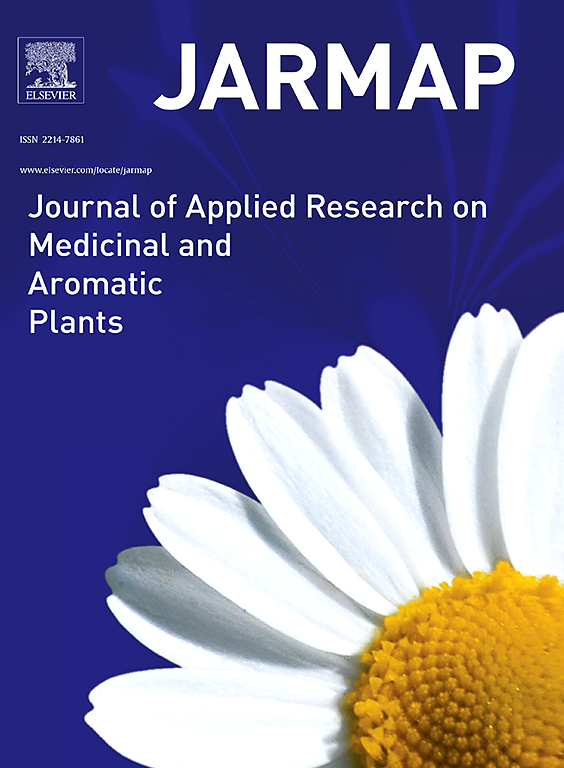Deciphering the genotypic superiority of turmeric (Curcuma longa L.) for yield and quality traits under three contrasting production systems
IF 3.6
2区 农林科学
Q1 PLANT SCIENCES
Journal of Applied Research on Medicinal and Aromatic Plants
Pub Date : 2024-10-15
DOI:10.1016/j.jarmap.2024.100592
引用次数: 0
Abstract
Turmeric (Curcuma longa L.) is a high-value spice and medicinal crop in the family Zingiberaceae. Growth, yield, and quality are influenced by geographical factors, production conditions, and climatic factors such as temperature, relative humidity, rainfall, and light. Breeding for controlled environments requires a focus on specific plant traits, like rapid growth, adaptability to low light conditions, and manipulation of plant size. Genotypes with maximum genetic plasticity are ideal for these conditions. The cultivation of turmeric must accelerate to meet demands for a increased yield and quality while minimizing environmental impact, achievable through controlled-environment production systems. Our study aims to identify superior turmeric genotypes for high yield and quality under controlled production systems, including vertical structures and greenhouse conditions. Results showed significant variation among 21 genotypes across three different production systems in terms of yield, dry recovery, oleoresin, essential oil, and curcuminoids. CIM Pitambar (185.76), Acc. 849 (176.50), Acc. 214 (149.50), and IISR Pragati (148.74) demonstrated superior fresh rhizome yield per clump under vertical structures. IISR Pragati performed well in both under greenhouse (959.08 g) and field condition (635.95 g). High recovery of cured turmeric was recorded in Acc. 14 (23.20 %) under vertical structures, Chhattisgarh Haldi 2 (25.60 %) under greenhouse and Uttar Rangini (23.14 %) under field conditions. Waigon Turmeric outperformed all other genotypes for oleoresin and essential oil contents and was found to be significantly higher across the production systems. The curcuminoids varied significantly and ranged from 0.12 % to 6.65 % across three production systems. Waigon Turmeric (2.13 %) was found to be superior for vertical structures, IISR Pragati (3.62 %) for greenhouse and IISR Prathiba (6.18 %) for field conditions. Greenhouse condition was found to be the best environment followed by field condition for fresh rhizome yield and essential oil content, whereas field condition was best for dry recovery, oleoresin and curcuminoids content. Our findings suggested that yield and quality are affected by the environments, and yield was found to be best in the greenhouse and quality traits performed best in field conditions.
解密三种不同生产系统下姜黄(Curcuma longa L.)产量和质量性状的基因型优势
姜黄(Curcuma longa L.)是一种高价值的香料和药用作物,属于姜科植物。姜黄的生长、产量和质量受地理因素、生产条件和气候因素(如温度、相对湿度、降雨量和光照)的影响。针对受控环境进行育种需要关注特定的植物性状,如快速生长、对弱光条件的适应性以及对植株大小的控制。具有最大遗传可塑性的基因型是这些条件下的理想选择。姜黄的种植必须加速,以满足提高产量和质量的要求,同时最大限度地减少对环境的影响,这可以通过受控环境生产系统来实现。我们的研究旨在确定在受控生产系统(包括垂直结构和温室条件)下产量和质量更高的优良姜黄基因型。结果表明,在三种不同的生产系统中,21 个基因型在产量、干回收率、精油、精油和姜黄素方面存在明显差异。在垂直结构下,CIM Pitambar(185.76)、Acc. 849(176.50)、Acc. 214(149.50)和 IISR Pragati(148.74)的每丛新鲜根茎产量较高。IISR Pragati 在温室(959.08 克)和田间(635.95 克)条件下均表现良好。在垂直结构下,Acc.14(23.20%)、恰蒂斯加尔邦 Haldi 2(25.60%)和 Uttar Rangini(23.14%)的固化姜黄回收率都很高。Waigon姜黄的油脂和精油含量优于所有其他基因型,而且在所有生产系统中都明显高于其他基因型。姜黄素在三种生产系统中的含量差异很大,从 0.12 % 到 6.65 % 不等。在垂直栽培条件下,Waigon 姜黄(2.13%)更优;在温室栽培条件下,IISR Pragati(3.62%)更优;在大田栽培条件下,IISR Prathiba(6.18%)更优。在新鲜根茎产量和精油含量方面,温室条件是最佳环境,其次是田间条件,而在干回收率、油脂和姜黄素含量方面,田间条件是最佳环境。我们的研究结果表明,产量和质量受环境影响,温室条件下产量最好,而田间条件下质量性状表现最好。
本文章由计算机程序翻译,如有差异,请以英文原文为准。
求助全文
约1分钟内获得全文
求助全文
来源期刊

Journal of Applied Research on Medicinal and Aromatic Plants
Pharmacology, Toxicology and Pharmaceutics-Drug Discovery
CiteScore
6.40
自引率
7.70%
发文量
80
审稿时长
41 days
期刊介绍:
JARMAP is a peer reviewed and multidisciplinary communication platform, covering all aspects of the raw material supply chain of medicinal and aromatic plants. JARMAP aims to improve production of tailor made commodities by addressing the various requirements of manufacturers of herbal medicines, herbal teas, seasoning herbs, food and feed supplements and cosmetics. JARMAP covers research on genetic resources, breeding, wild-collection, domestication, propagation, cultivation, phytopathology and plant protection, mechanization, conservation, processing, quality assurance, analytics and economics. JARMAP publishes reviews, original research articles and short communications related to research.
 求助内容:
求助内容: 应助结果提醒方式:
应助结果提醒方式:


